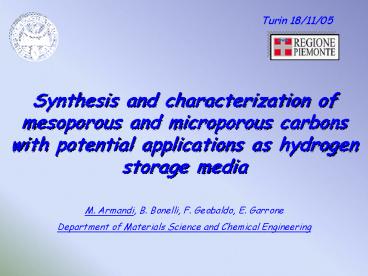Presentazione di PowerPoint PowerPoint PPT Presentation
1 / 19
Title: Presentazione di PowerPoint
1
Turin 18/11/05
Synthesis and characterization of mesoporous and
microporous carbons with potential applications
as hydrogen storage media M. Armandi, B.
Bonelli, F. Geobaldo, E. Garrone Department of
Materials Science and Chemical Engineering
2
Hydrogen storage is a key enabling technology for
the advancement of hydrogen and fuel cell power
technologies in transportation, stationary, and
portable applications.
- Besides conventional storage methods (i.e. high
pressure gas cylinders or liquid hydrogen), much
interest is payed to the study of materials able
to physisorbe hydrogen. The challenge is to find
materials which can adsorbe hydrogen,
characterized by the following properties - Low molar weight high surface area
- Cheap
- Rapid kinetics for absorbing/desorbing H2
- Store large quantities of hydrogen reversibily
3
Synthesis of SBA-15 carbon replica Carbon source
sucrose (gives the best structurally ordered
material and most reproducible results). Calcined
SBA-15 is impregnated with an acidic solution of
sucrose. Polymerization 6h at 373 K 6h at 433
K and pyrolisis at 1173 K in N2 flux or under
vacuum Silica is removed completely via HF 5
leaching (as checked by X-ray florescence)
C-N2
Ryoo et al. Carbon, 40, 2673 (2002)
4
XRD Low angles
d(100)
With carbon replicas a limited loss of long
range order is observed
d(110)
d(200)
C-N2 96 C-v 96
5
N2 adsorption isotherms at 77 K
6
FESEM Pictures morphological characterization
Carbon replica C-N2
Morphology depends on the synthesis conditions
(silica source presence of co-surfactant etc.)
Parent SBA-15 silica
The rope-like morphology of parent SBA-15 is
mantained
7
TEM Pictures
Carbon replica C-N2
8
Extent of graphitization Micro-Raman spectroscopy
D-band 1353 cm-1 Loss of long-range hexagonal
symmetry
C-N2
C-v
Graphite crystal Band G at 1582 cm-1 FWHM 16 cm-1
Renishaw, Ar laser (514.5 nm) Department of
Physics, Politecnico di Torino
9
Study of the surface properties by means of XPS
Sample C-N2
- B.E. 284.5 eV gt C-C bonds
- B.E. 286.8 eV gt C-OH surface groups
- B.E. 289.8 eV gt carboxyl groups or C-F (?)
The presence of OH groups is confirmed by FTIR
spectra (broad band of O-H stretch vibration in
the 3600-3200 cm-1 range)
10
ZEOLITE CARBON REPLICAS
Commercial Na-Y zeolite (Zeolist)
Impregnation with furfuryl alcohol followed by
Propylene CVD
Propylene CVD at 1073 K
C-Y-2
C-Y-1
Zeolite removed completely by means of leaching
with 5 HF sol. at r.t. and concentrated HCl at
333 K (as checked by X-rays fluorescence).
Kyotani et al., Carbon 40 (2002) 2367
11
XRD
Notwithstanding the occurrence of an amourphous
phase, the main peak of the zeolite is mantained
12
N2 adsorption isotherms at 77 K
TYPE I ISOTHERM
Surface area of about 2200 m2 g-1
13
FESEM Pictures morphological characterization
Parent Na-Y Zeolite
Carbon replica C-Y-2
The zeolite morphology is mantained
14
TEM Pictures
Carbon replica C-Y-2
15
Extent of graphitization Micro-Raman spectroscopy
D-band 1355 cm-1 Loss of long-range hexagonal
symmetry
Band G at 1606 cm-1
C-N2
C-Y-2
C-v
C-Y-1
Renishaw, Ar laser (514.5 nm) Department of
Physics, Politecnico di Torino
16
Study of the surface properties by means of XPS
Sample C-Y-2
- B.E. 284.4 eV gt C-C bonds
- B.E. 286.9 eV gt C-OH surface groups
- B.E. 290.5 eV gt carboxyl groups or C-F (?)
The presence of OH groups is confirmed by FTIR
spectra (broad band of O-H stretch vibration in
the 3600-3200 cm-1 range)
17
H2 adsorption at 77 K
- Completely reversible adsorption
- Max volume adsorbed 165 cm3/g (1,4 wt) for C-Y-2
- Differnt mechanisn of adsorption for C-Y-2
18
Test in a high-pressure autoclave for
hydrogenation
- High pressure autoclave connected with Buchi
pressflow gas controller bpc (HySy_Lab) - All samples tested at room temperature at Pmax
14 atm - No hydrogen adsorption occurs in this condition
(in agreement with literature data)
H. G. Schimmel et al., Chem. Eur. J., 2003, 9,
4764 M. Rzepka et al., J. Phys. Chem. B 1998,
102, 10894
19
CONCLUSIONS
- Several mesoporous silica and zeolite carbon
replicas have been obtained by casting procedure.
- Carbon replicas showed high surface areas and
low specific weight but still, but a low
physisorption capacity .
Work in progress future projects
- Evaluation of H2 adsorption at p gt14 atm.
- New synthesis routes for porous carbons.
- Founctnalization of carbon replicas
- Dispersion of metals/metal oxides
- Study of new porous system (?)

